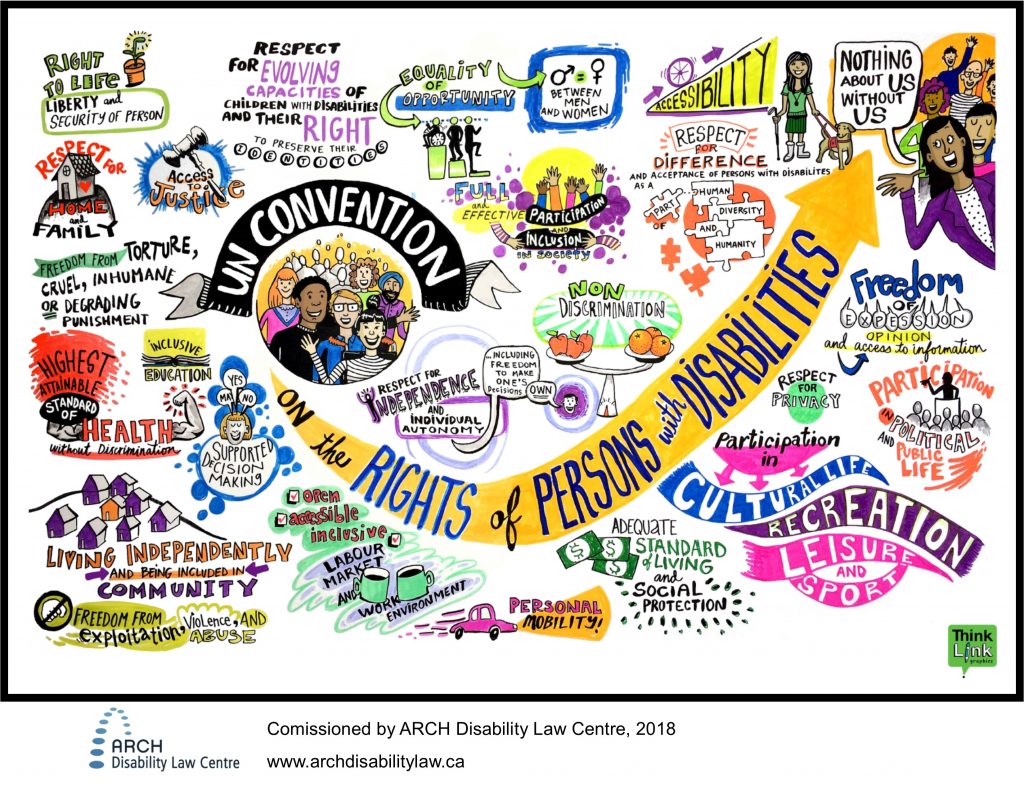Written by guest blogger, Emily Williams
Did you know that rights of persons with disabilities are protected under international human rights law?
International human rights law (IHRL) aims at protecting and promoting human rights globally. IHRL began with the adoption of the Universal Declaration of Human Rights (UDHR) in 1945. The UDHR led to the development of a variety of different legally binding treaties that detail protections for different human rights, including the prohibition of torture, women’s rights, children’s rights, and persons with disabilities.
Convention on the Rights of Persons with Disabilities
The Convention on the Rights of Persons with Disabilities (CRPD) was drafted in conjunction with organizations that promote disability rights. Canada, including Nova Scotia, ratified the CRPD in 2010. This means that both the federal government and the Government of Nova Scotia must take measures to ensure the rights in this treaty are respected.
The CRPD includes many different rights, such as the right to life, education, health, work, adequate standard of living, equality before the law, access to justice, freedom from torture, freedom from violence, the right to live independently and be in the community, and respect for privacy. The treaty is guided by the movement to a human-rights based approach to disability. This approach recognizes that persons with disabilities have rights and that disability is an evolving concept. In other words, the idea of disability results from “the interaction between persons with impairments and attitudinal and environmental barriers that hinders their full and effective participation in society on an equal basis with others”.[1] One of the goals of the treaty is to ensure persons with disabilities can participate on an equal basis in society.[2] The treaty also highlights the importance of recognizing the autonomy of persons with disabilities, the freedom to make their own choices, and for them to have the opportunity to be involved in decisions that affect them.[3]
Nova Scotia’s Accessibility Act
When the Government of Nova Scotia enacted the Accessibility Act, it was informed by the CRPD. This legislation, which aims to remove barriers for persons with disabilities, acknowledges that the CRPD obliges Canada “to take appropriate measures to achieve accessibility and to develop and monitor minimum accessibility standards”.[4]
Committee on the Rights of Persons with Disabilities
Since Canada has ratified the CRPD, Nova Scotians with disabilities who believe their rights have been violated under the Convention can file a case with the Committee of the Rights of Persons with Disabilities. This Committee consists of independent experts who are responsible for overseeing implementation and respect of the CRPD. After a case has been reviewed in Canada, it can go to the Committee where they can decide if Canada or Nova Scotia violated rights. This is an important protection as it gives persons with disabilities an additional level of remedy if a rights violation was not remedied at the domestic level.
Why is this important?
The CRPD illustrates that there is international agreement that persons with disabilities have distinct and unique human rights. It represents society moving away from a paternalistic to a rights-respecting attitude for persons with disabilities.
Additional Resources
- The following video from Sightseers, an international non-governmental organization, working with people with visual impairments and other disabilities, explains the treaty in a clear and concise manner: https://www.youtube.com/watch?v=St61pEPUuFw
- For the full text of the treaty, please see this link: https://www.ohchr.org/en/hrbodies/crpd/pages/conventionrightspersonswithdisabilities.aspx
- The Committee on the Rights of Persons with Disabilities provides copies of the treaty and other documents relating to the treaty in plain language and easy read versions: https://www.ohchr.org/EN/HRBodies/CRPD/Pages/PlainAndERV.aspx
- The United Nations Office of the High Commissioner for Human Rights has a training guide for individuals who are interested in promoting the rights of persons with disabilities and holding governments accountable for the obligations under the CRPD: https://www.ohchr.org/EN/Issues/Disability/Pages/TrainingmaterialCRPDConvention_OptionalProtocol.aspx
Sources
[1] CRPD, Preamble (e).
[2] CRPD, Preamble (k).
[3] CRPD, Preamble (n), (o).
[4] Accessibility Act, SNS 2017, c 2.



Add a comment to: Internationally Recognized Rights for Persons with Disabilities